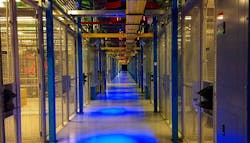Coinbase Plans Low-Latency Colocation for Bitcoin Trading
Wall Street is embracing bitcoin and ready to build a financial ecosystem around cryptocurrency. That includes low-latency colocation, which has been a significant business for data center companies in major financial hubs.
Bitcoin specialist Coinbase, which manages more than $20 billion in cryptocurrency assets, has announced its entry into the data center business as part of a suite of services for institutional investors. With its Coinbase Markets offering, the company will provide a centralized pool of liquidity for all its cryptocurrency products, which currently include Bitcoin, Ethereum, Bitcoin Cash and Litecoin.
“Over the course of the year Coinbase Markets will introduce new features like low latency performance, on-premise datacenter colocation services, institutional connectivity and access, and settlement and clearing services,” the company said. “These additions will allow for a more efficient price discovery process to occur, creating tighter markets, deeper liquidity, and increased certainty of execution.”
A New Opportunity in Cryptocurrency?
The emergence of low-latency trading for bitcoin marks a potential shift in the data center industry’s relationship with the cryptocurrency world. Until now, the primary bitcoin-related use of data centers was for “mining” – processing transactions to secure the blockchain, an online ledger. Bitcoin miners yearn for cheap space and power, and lots of it. They typically run high-density racks and invest less in backup infrastructure, which is a key component of the value of a commercial data center.
As a result, utility-scale bitcoin mining has largely become a do-it-yourself operation in which companies create “hashing centers” in warehouses, modular data centers or immersion containers in which servers are dunked in pools of coolant. Some data center providers have begun offering “variable resiliency” space with limited generator or UPS support as a lower-priced option for bitcoin mining companies. [click_to_tweet tweet=”The emergence of low-latency trading for bitcoin marks a potential shift in the data center industry’s relationship with the cryptocurrency world.” quote=”The emergence of low-latency trading for bitcoin marks a potential shift in the data center industry’s relationship with the cryptocurrency world.”]
The financial industry’s interest in cryptocurrency trading creates another option – low-latency colocation in which the tenants are well-heeled Wall Street firms and hedge funds, who may pay a premium to execute trades faster than their rivals. If this ecosystem succeeds, it would create a more lucrative opportunity for data centers to provide services driven by surging interest in bitcoin and other cryptocurrencies.
Cryptocurrency Arrives on Main Street, Wall Street
Wall Street firms have long been fascinated with bitcoin and blockchain technologies, and are now developing products allowing investors to profit from price movements in cryptocurrencies. Bitcoin futures launched late last year, sparking a historic run-up in price for bitcoin.
Coinbase, a San Francisco firm backed by some of Silicon Valley’s largest venture capital firms, is moving aggressively to capitalize on that interest. The company is launching a suite of products that include trading tools, market research, crypto storage and custody, auditing and reporting, and a “white-glove service to help institutional investors navigate the increasingly complex world of crypto asset investing.”
“There is clear demand from institutional clients and financial services professionals for more specific solutions with regard to cryptocurrencies that address their sophisticated needs,” said Adam White, Vice President and General Manager of Coinbase Institutional. “Through new products like Coinbase Prime and Coinbase Custody, we’re building the necessary capability for institutions that allows cryptocurrencies to be traded and stored in a compliant, trusted and efficient manner.”
Coinbase Focused on Chicago
Coinbase’s move into colocation summons echoes of the financial industry’s focus on high-frequency trading (HFT), which created demand for proximity colocation, in which providers could charge a premium for data center space near the matching engines for major exchanges. Low-latency trading boosted the data center business in Northern New Jersey and Chicago, particularly for providers like Equinix, Savvis and Telx that housed key exchange infrastructure.
Data Center Frontier Special Report: The Chicago Data Center Market. Download It Now.
Coinbase is focusing its operations on Chicago, the largest trading hub for commodities and related products. This decision is likely driven by U.S. government policy, which treats bitcoin and other cryptocurrencies as commodities regulated by the Commodities Futures Trading Commission (CFTC) rather than currencies.
Coinbase is based in San Francisco, but has opened an office in Chicago and is hiring a team of engineers. The company’s Chicago operations are led by Paul Bauerschmidt, a former executive of the CME.
Coinbase hasn’t provided details on its plans for data center services, or how much capacity it will need to launch and grow the services. The Chicago data center market features several financial trading hubs, most prominently the Digital Realty carrier hotel at 350 East Cermak, which houses a low-latency trading ecosystem for Equinix. Both CoreSite and Digital Realty operate data centers in the financial district, immediately adjacent to major exchanges. A new player is the CyrusOne campus in Aurora, which houses electronic trading operations for the CME Group.
We’ve reached out to Coinbase seeking additional details
About the Author



